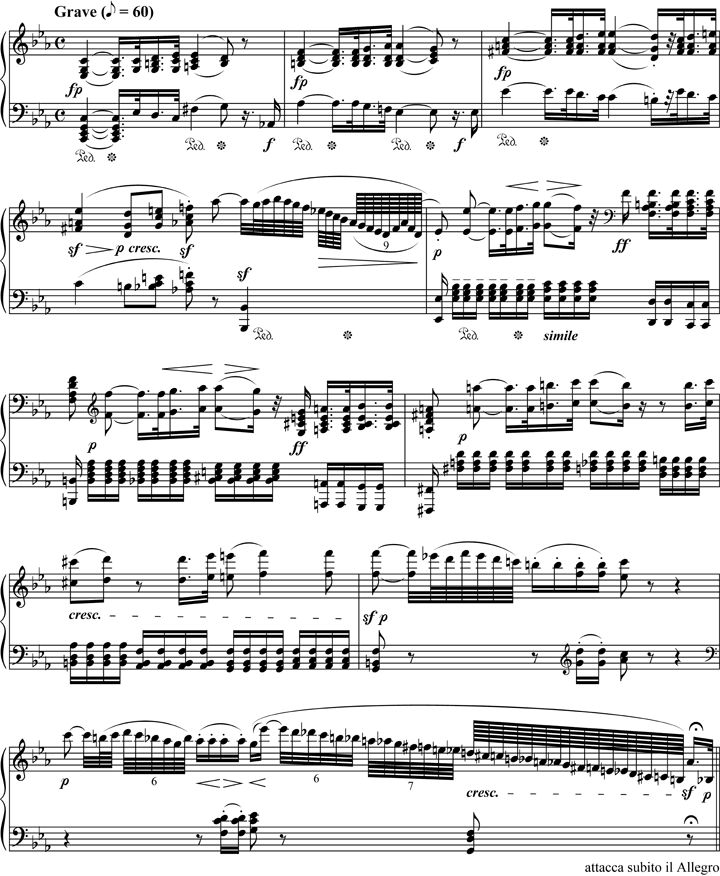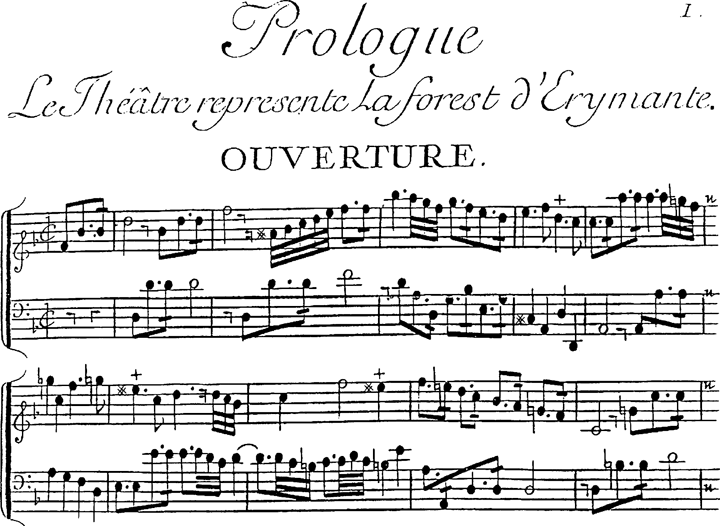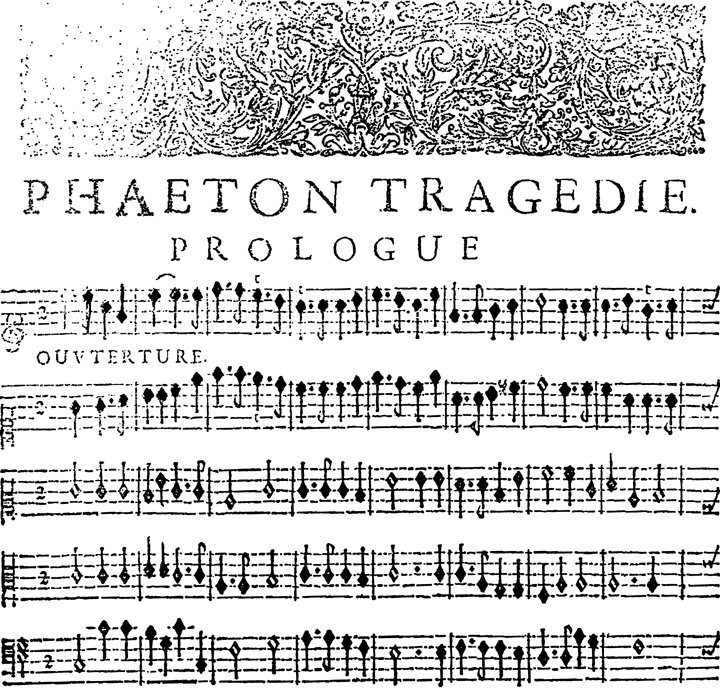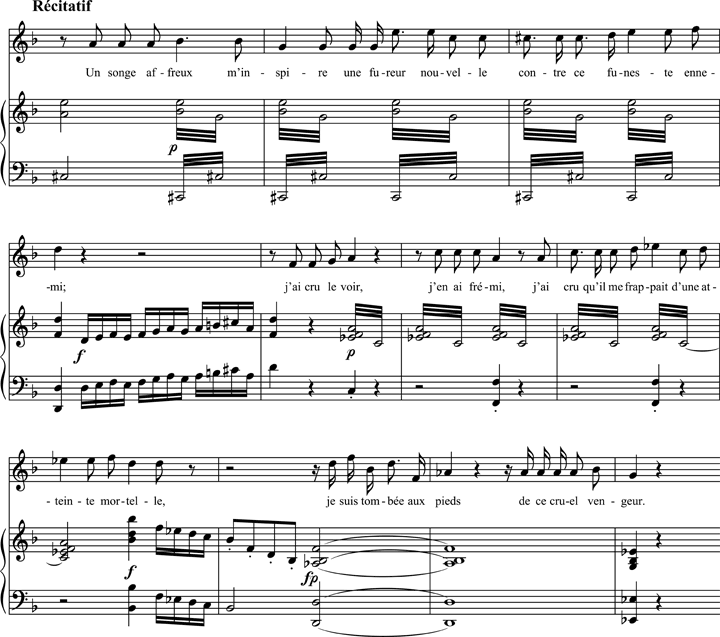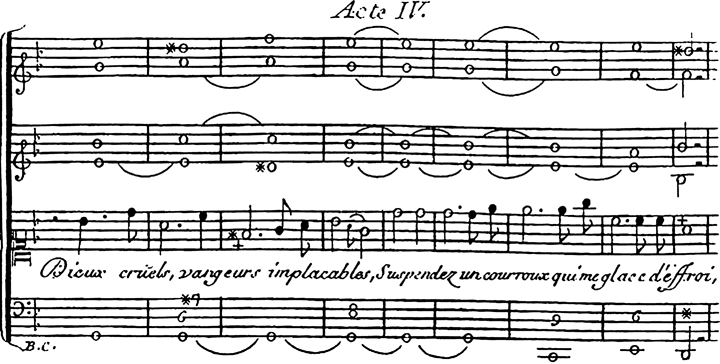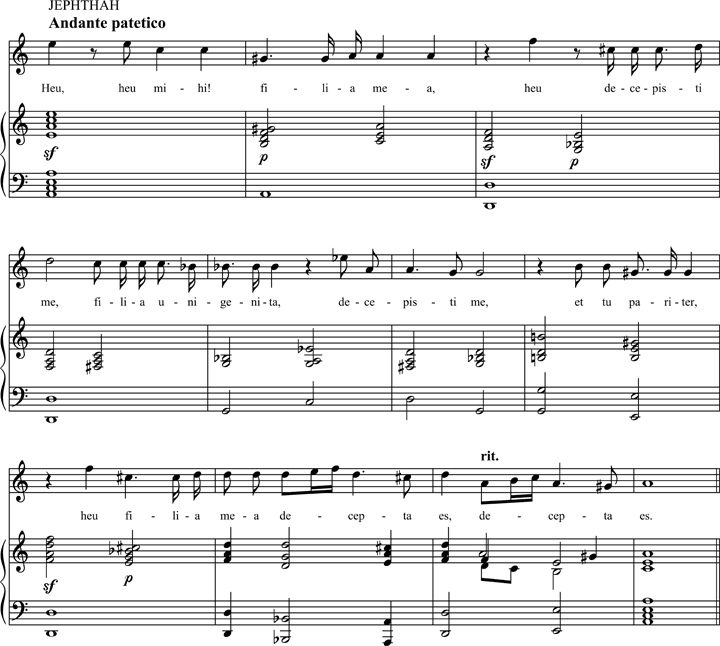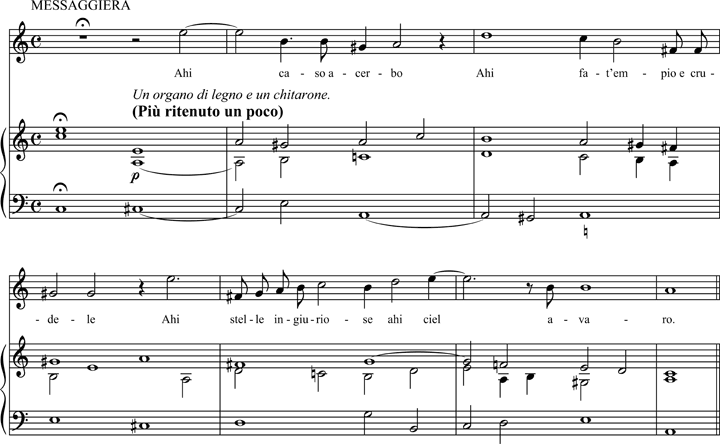Once more on musical topics and style analysis
A critical examination of Agawu’s analysis of the introduction to Beethoven’s Pathetic Sonata
Ana Stefanovic
The article begins with the analysis of the introduction to Beethoven’s Pathétique Sonata as presented in Playing with Signs by Kofi Agawu, with the intention of posing several questions concerning meaning and function of musical “topics.” In this context, attention is drawn to terminological ambiguities, i.e. to ambiguities in defining the concept of topics, especially in view of similarities and differences with the concept of topos. Subsequently, the question may be asked, “What constitutes a musical topic/topos?” If it is supposed that it represents a sign-function (Umberto Eco), what is a minimal entity that is sufficient to be referred to as a topic/topos? Consequently, what kind of relations does it establish towards style, which still shows itself to be the main referential plane (the content) of topical expression? Finally, the question arises of whether an ‘atomistic’, taxonomic approach to musical “topics” denies – contrary to the intentions of the authors using this term – the semantic aspect of music in which the topics ‘may be found,’ reducing it to the ‘play’ of formal elements, i.e. to purely ornamental function of rhetorical locus communis. Should the place of topic/topos perhaps be looked for elsewhere, in the plane of discourse and narrative structure of the musical text?
In Playing with Signs Kofi Agawu[1] presented a semiotic analysis of the common-practice repertoire based on musical “topics.” Agawu’s theory and methodology of analysis have been adopted, with minor or major broadening of theoretical standpoints, by other authors from English-speaking countries involved in the semiotic research of music, such as Raymond Monelle,[2] Robert Hatten[3] and others. Agawu’s list of twenty-seven “musical topics,” distilled from an earlier book by Leonard G. Ratner,[4] puts forth a “provisional universe of topic” formed on basis of the analyzed corpus.[5] This list of topics, as well as their “interplays,” represents a frame for the analysis of classical music. Agawu also adopts Ratner’s division of topics into two large “classes.” In the first class – the one entitled musical types – we find “minuet, passepied, polonaise, sarabande, bourrée, contredanse, gavotte …;”[6] from this we can conclude that musical types refer to the dances, which, as the author says, “classic music inherited from the earlier part of the 18th century.” The second class, entitled styles of music, includes “military and hunt music, fanfares, horn-calls, singing style, brilliant style, French ouverture, musette/pastorale, Turkish music, Sturm und Drang, sensibility or Empfindsamkeit ….”[7] Differing from the first class, in which we can find a certain homogeniety, the second one encompasses a wide spectrum of musical phenomena among which we can discern immediately categorial differences. These include differences between signals (understood as a semiological category); genre (French overture); style (Empfindsamkeit); and movement (Sturm and Drang). In the second case, however, Agawu has not determined whether these musical phenomena belong among inherited ones or not. Nevertheless, Agawu uses these two classes of topics as the basis for the analysis of classical works. The aim of this critical examination of Agawu’s analysis is to make a contribution to fruitful examinations that were presented up to now, as well as to indicate a possible expansion of their scope. Consider Agawu’s analysis of the introduction to Beethoven’s Pathetic sonata (example 1):
At least three topics are introduced in the opening measures of the movement: sensibility, cadenza, and French overture. The broken rhetoric of the opening measures, together with the emphasis on diminished-seventh harmony, recalls C.P.E. Bach specifically, or the sensibility style in general. The soloistic display on the last bar of measure 4 may be heard as a mini-cadenza, and therefore as an allusion to the concerto style …. The sense of an overture is conveyed by the ‘Grave’ tempo indication, the ordinal position of the passage, and the characteristic dotted rhythm. Beginning in measure 5, we hear a songlike melody that appears to be an aria, complete with a throbbing accompaniment. But, this aria is not allowed to sing through. Rather, it is interrupted by a diminished seventh-laden gesture that not only recalls the opening of the movement …, but also suggests … another topic, Sturm und Drang. Measures 5–8 are dominated by this alternation between Sturm und Drang and aria, and it is not until the beginning of measure 9 that the interplay ceases, replaced by allusions to the delicate aspects of the sensibility style. Then follows the cadenza leading to a final resolution … of measure 11.[8]
Example 1. Beethoven, Sonate Pathétique (1799), op. 13, Introduction, mm. 1–10
This analysis raises at least two questions. First, what is the relation of the introduction to Beethoven’s Pathetic sonata and the French overture? Second, why is the appearance of a diminished seventh chord first associated with Empfindsamer style and then with Sturm und Drang? Agawu, anticipating such questions, gives a preemptive answer: “Some critics would maintain that any discourse that is sustained by notions of ‘pointing to,’ ‘suggesting’ or ‘referring to,’ instead of one that answers positively or negatively the question ‘is it or is it not?’ is doomed to failure because it is based on shaky premises. To argue in this fashion, however, is to fail to appreciate the vitality of a critical stance that, by acknowledging that there is no such thing as ‘topic’ outside its particular manifestation in a given musical context, retains a dialectical interplay between the conceptual or archetypal and its idiosyncratic realization.”[9]
“Particular manifestation in a given context,” however, supposes some earlier foundation and confirmation of identity, if only to be able to establish a subsequent “stylization” or appearance of “replicas” (to use Eco’s terms)[10] but also to be able to retain a dialectical interplay between the conceptual/archetypal and the idiosyncratic. Moreover, Agawu himself affirms elsewhere that “such thing as a topic” also exists “outside its particular manifestation”: that is to say, “a given topic may assume a variety of forms, depending on the context of its exposition, without losing identity.”[11] This recalls Monelle’s stance, itself inspired by Eco: “Musical topics are general types, capable of being represented by particular tokens”.[12] In Eco’s theory of sign production we find a precise type-token division: “Tokens of the same type can possess individual characteristics, provided that they respect the pertinent ones fixed by a type.”[13] If we determine, together with these authors, that the topic exists also as an archetype, or simply, as a type, as well as a specific manifestation, let us return to the question of the relation between the opening of the Pathetic sonata and the French overture. Although the French overture is usually considered to be a genre, not a style – French overtures were composed in different styles, and multiple styles can be found within a single overture – let us start from the presumption that it represents a type. What, then, are the characteristics fixing its identity? Is slow tempo and dotted rhythm sufficient for the perception of Beethoven’s introduction as a replica, imitation or evocation of the generic type[14] of a French overture, but, above anything else, also sufficient for an interpretation of the meaning of the sonata’s introduction specifically? If we compare the opening bars of the introduction of the Pathetic sonata to the introductory bars of three French overtures going backwards from Beethoven – overtures of Gluck, Rameau and Lully (examples 2 a, b, c) – we find that we can neither establish a connection by contiguity nor determine that the meaning is the same. In the first place, even on the intuitive level, an opposition of the dramatic and the solemn is established. However, that opposition can easily be rationalized by citing the lack of fixed, stable characteristics of the French overture in Beethoven’s introduction and, conversely, of Beethoven’s introduction in the French overture. In the Baroque French overture, whether major or minor, one finds static harmony, a reduction of harmonic progression to the basic tonic-dominant relation, that is, to a cadence, then a pronounced diatonic movement of the melody through broken consonant chords or through conjunct motion. In Beethoven’s introduction, in contrast, the musical flow is based on a fast harmonic rhythm, on a progression striving forward, on the juxtaposition of dissonant and consonant structures with insistence upon dissonant potential of diminished seventh chord supporting continuous “lament” appoggiaturas in the melody. The dynamic potential of these introductory measures, as contrasted with the static harmonic rhythm of the French overture, is supported also by the difference between temporal discontinuity and continuity. Beethoven’s introduction is supported not only by a fragmentation of discourse, but also by dynamic oscillations, and by crucially important rhetorical gradation, realized through the sequence. It is obvious here that not only fixed and stable elements of an ouverture “type” are lacking, but indeed, the main features of its stylistic model are practically called into question.
Example 2a. Gluck, Armide (1777), Ouverture, mm. 1–5
Example 2b. Rameau, Hippolyte et Aricie [first edition, Paris: l’auteur: Boivin: Le Clerc, 1733], Ouverture, mm. 1–11
Example 2c. Lully, Phaëton [first edition, Paris: Ballard, 1683], Ouverture, mm. 1–8
Consider now several examples that, although outside of the genre field of French ouverture, also include dotted rhythm and slow tempo. The first is the well known four-measure introduction to the Kyrie of Bach’s Mass in B minor. Do we have, in this case, an association to French overture? Or is the example closer in meaning to the introduction to the Pathetic sonata? To put it another way, is the introduction to the Kyrie of Bach’s Mass an announcement of the king or of the drama? If it announces the drama, which is reasonably to be expected considering the contents of the text of the Mass, it is because the musical expression and style, apart from dotted rhythm and slow tempo, depends considerably upon a pronounced function of the diminished seventh chord; upon appoggiatura structures of lament; and upon fast harmonic rhythm. These features, together with rhetorical gradation realized through a sequence, have an effect upon the dynamic aspect of the musical flow. However, if in Bach’s introduction it is not quite obvious that the style in question is based upon a discursive/dramatic principle, the fact is made clearer through comparison to the style and meaning of the recitative in music drama. Going backwards again, a set of stylistic features identical to the one from the introduction to Beethoven’s sonata can be found in the recitative which intends to evoke dramatic feelings through expressive effects of harmony, orchestra (continuo), prosody, and rhetorical devices.
In the examples 5–7, taken from a two centuries long tradition of music drama, we find not only slow tempo and dotted rhythm, but also the use of diminished seventh chord and rhetoric elements of gradation and lament: ascending sequences and melodic descending appoggiaturas. This is the case in a well-known scene from Gluck’s Armide (1777, I,1): the heroine speaks with great excitement about her dramatic dream, full of conflict and bound for a tragic outcome (example 3). In using this style Gluck had predecessors both close and remote. Staying with the French repertoire, we can see that the prayer of Rameau’s Fedra is indebted to the same spectrum of stylistic means (example 4). Further examples exist outside the frame of French style. In Carissimi’s oratorio Jephtah, we find the same stylistic hallmarks used to express the heightened drama of the hero’s cry for his sacrificed daughter (example 5). And finally, the source of style in question can be found in the very base of la dramma per musica: Monteverdi’s Orpheus. When the Messagiera announces the death of Eurydice, the style in question expresses the affects of sorrow and dismay, the drama of the situation (example 6). The fact that we find this style as far back as the very beginning of the tonal tradition suggests a unity of features across the common-practice period. Directly from Baroque representation of drama and affetti, this pattern of stylistic features is found as well in the redende Prinzip, the basis of the Empfindsamer style of C.P.E. Bach (example 7). In the following ‘Classical’ era, the style became intensified under the whirlwind of ideas emerging from Sturm und Drang, which revived the style in question as a reaction to ‘formal’ style galant, thereby continuing a Baroque dramatic tradition and its stylistic constants.
Example 3. Gluck, Armide (1777), I,1
Example 4. Rameau, Hippolyte et Aricie (1733), IV, 4
Example 5. Carissimi, Jephtah (1650)
Example 6. Monteverdi, L’Orfeo (1607), II
Example 7. C.Ph.E. Bach, Sonata in B flat Major W.48/2, Prussian (1742), Adagio, mm. 1–5
The essence of establishing the genre of music drama lays in the theoretical upturn at the end of the 16th and the beginning of the 17th century by which Galilei[15] and the Moderni, and after them the whole theoretical tradition of the 17th century, distanced themselves from musical representation of separate lexical unities in favor of the representation of the meaning taken as a whole – meaning realized on the syntagmatic level, the level of discourse. The question, then, is whether the topical semiological approach to the age of Classicism, in which this concept of the discursive foundation of music strengthens itself by further development of the tonal system, in fact revives through analysis a pre-Baroque, pre-tonal, and indeed pre-discursive dissemination of a musical semiological field – its particularization into separate minutiae which provoked, as Gallilei would say, “laugh or contempt.”[16] This is all the more true in cases where the examination of separate entities brings into question the very status and function of the sign.
Let us return to Agawu’s analysis. In the very first syntagmatic whole, supported also by syntactic integrity, the author points to three “topics.” The first is the diminished seventh chord and the style of Empfindsamkeit that it indicates; the second, the dotted rhythm and the slow tempo that suggest the genre of French overture; and third, the concertante virtuosity of the “cadenza.” By this fact alone, this syntagmatic whole is denied not only coherence of meaning, but also meaning itself. Dotted rhythm and slow tempo do not, as we have seen, indicate French overture by themselves. Indeed, do they ‘indicate’ anything at all, in the sense that they stand for something absent? The dotted rhythm in the Baroque and Classical eras can be connected by association to at least three styles: the galant (dancing); the solemn (French overture); and the dramatic or sensibility style of the recitative. The actual spread of the slow tempo needs not be discussed at all. The fact that they all together could be found in the style which does not, in the least, reflect any connection to the French overture, but represents a meaning quite contrary to it, has been shown in the previous examples. Two questions, at least, can therefore be asked in this regard: are dotted rhythm and slow tempo ‘signs,’ as Agawu says? Because if “topic” is a sign,[17] comprised of those two elements, then they separately or together must acquire a “sign function”: that is, they must establish a relation between the designator and the designee, between the expression and the contents. In the best case, they represent, in Eco’s terms, signs without meaning, evoking various “semes” (galant, dramatic, etc.); but they do not by themselves allow “concretization of any state of consciousness.”[18] In the worst case they represent only “values” – units without “semes,” designators without designees. Let us again evoke Eco: they are “like an arrow which needs a specific colour, a specific direction and must appear on a sign-board situated at a specific place” in order to have a meaning,[19] or, like an isolated word which “appears before us as a virtual part of various sentences which tell of different things.”[20] It is clear that these entities, treated separately by Agawu, are unable to initiate a process of semiosis, which “never develops by way of exchanging isolated signs,”[21] but necessitates to be based on the context, that is – organized into utterances – text and discourse. Or, from the perspective of Goodman’s concept of exemplification – denotation by inversion – dotted rhythm can express excitement, for example, by way of metaphorical exemplification.[22] But the establishment of the epithetic, that is, predicative function – spreading out on syntagmatic plane, the plane of utterance – is necessary for the constitution of meaning: dancing excitement, solemn excitement, tragic excitement.[23] The epithetic function coming from the context is the one that adds – among other things – colour, direction, and place to dotted rhythm. In Eco’s words, “there is no semiotics of the sign without semiotics of the discourse;” “the theory of sign as a separate entity is, in any case, unable to explain aesthetic use of signs.”[24]
The above statement acquires added significance with regard to the question of style, according to the theorists under discussion. Whether it is examined on the level of code, coding rules, or discourse, style can be observed only as a complex expression, established by code as well as by context. In his intention to theorize Agawu’s concept of the “topic,” Raymond Monelle resorts to Pierce’s three-fold relation of sign to its referent, and understands the “topic” as a symbol,[25] crucially leaning upon indexical meaning, which may be mediated by iconic one. In that sense the author differentiates between two kinds of topic: the iconic and the indexical.[26] In the first case we are concerned with the indexicality of the object – meaning is assured by the contents of the topic, not by musical expression. The sound of a cuckoo’s call, for example, indexically denotes pastorale. In the other case, in Monelle’s opinion, we can speak of the indexicality of the “musical item itself” – the fanfare motive or the French overture – when “topics do not signify by virtue of resemblance, but because they reproduce styles and repertoires from elsewhere.”[27] In that way, according to Monelle, “as the slow movement in the Jupiter symphony is in Sarabande meter it represents the dance measure itself.”[28] But ternary meter does not signify Sarabande by itself; similarly, dotted rhythm does not signify French overture. Sarabande and French overture also imply fields of content mediated by musical features, but that content cannot be reached by isolating elements: separate stylistic features whose sign status is questionable, and ability to carry meaning practically nil. That is why Monelle’s examples of French overture “topics,” adopting Agawu’s concept and relying exclusively on “slow dotted rhythm,” include such a wide range of effects of meaning and means of expression: the Adagio from Schubert’s First Symphony, the introduction to Beethoven’s Ninth Symphony, the beginning of the Kyrie from Britten’s War Requiem, and Shostakovich’s Fifth Symphony).[29] Clearly these examples do not, by any means, indicate one single meaning.
The fundamental problem of the concept of “topic” lies in the fact that none of the authors concerned with it has expressed clearly enough that the referent field of the “topic” is the style. And style is, if we go back to Goodman, “a complex property that can be divided into many stylistic properties.”[30] For a property to be stylistic it must, according to Goodman, represent a “property of the functioning of the works as a symbol …. Style has to do only with symbolic functioning of work as such.”[31] In that sense “literal signature is no feature of style.”[32] Taking into account Goodman’s concept and typology of reversed denotation, as well as Genette’s development of this concept,[33] we can say that work literally exemplifies genre, tonality, form, meter, or tempo, but metonymically – according to similarity with other works – it exemplifies style because this metonymical exemplification of style depends on metaphorical exemplification of its content plane: that is, on its symbolic function. This function is established by a process of semiosis: by relations between elements with symbolic potential, which form a complex unity on the discursive plane. Therefore, the first syntagmatic whole of the introduction to the Pathetic sonata can literally exemplify only the genre of the sonata, or the structural function of the introduction, or dotted rhythm; but metonymically, it exemplifies style which metaphorically, symbolically mediates the meaning of drama. That is why we can say that the introductory measures of the Pathetic sonata do not include a mixture of references to stylistic, generic, and structural elements, but that they present a single dramatic style whose origin lies in Baroque music drama. Within that framework, a metaphorical transfer was established on the basis of the relation of the music to the text; subsequently this meaning was fixed through use and repetition – as Eco would say, it was stylized – and finally, it was structured by codified rules that enabled it to manifest itself in various cultural, social and aesthetic contexts.
The lack of precision in defining style as topical reference is related to the unclear use of the very concept of “topic” and its content. So forged and used, it indicates, at the same time, in a very general manner, rhetorical locus communis and the theme, without clearly defining its scope or meaning. The concept of topos, on the other hand, has a far more precise and obligatory meaning.[34] Todorov’s definition of this concept, given in opposition with the motif is as follows: “If several motifs form a stable, recursive configuration, it is signified as topos.”[35] We find a similar definition from Ducrot and Schaeffer, emphasizing opposition of the topos and the theme: “a comparative and evolutionary study of historically pregnant motifs which form a stable configuration: that is the concept designated as topos. The presence of the same topos in two different works does not mean that the same theme is present in them, because motifs are thematically polyvalent.”[36] A common point in both definitions is that topos implies a stable configuration of several pronounced motifs, as well as the fact that it cannot be considered equal to the motifs – that is, to the theme. Consequently, themes can be changed, but the topos need not, or vice versa. That is why in the consequent of introduction to the Pathetic sonata, a change of topos was possible, but not a change of theme at the same time: here, topos of lyricism, by which total symbolic configuration is changed (implying disappearance of all pregnant motifs of dramatic style, of topos of drama), finds itself in sharp opposition to previous field of meaning. The sharpness of this opposition is regulated by the very cultural context determined by the Sturm und Drang movement. (Interaction of lyric, drama, and cantabile – or “singing style,” “aria,” as Agawu would say – comes from the interaction and parallelism of different narrative lines in music drama: from Gluck on, this growth can be followed through the whole Romanticism.) Finally, the third topos of this introduction – an ornamented, quasi-flute or quasi-soprano coloratura, frequent onomatopoeia of nightingale song in the pastorale – style galant, in which this sign of pastorale represents only one of the motifs,[37] defines still broader cultural context of the period of Classicism. These three topoi do not only regulate the syntactic structure (antecedent, consequent, extension) of Beethoven’s introduction,[38] but also regulate a narrative configuration of high Classical style, ensuring the stability of its meaning. (Indeed, an analysis could show that the whole Pathetic sonata, and not only that particular work of high Classicism, can be understood through relations of these three topoi).
Does this ‘play with topics’ – the atomistic and taxinomic approach to musical “topic” – ultimately deny semanticity to music in which the topics are found, contrary to the intentions of its author? That is the reduction of “topic” to the play of several formal and isolated elements, namely, to the old rhetoric of logos, to pure eloquence, to “cosmetic,” ornamental rhetoric (as Plato would say), neglecting at the same time the rhetoric of pathos which alone assures unity of meaning and continuity of discourse? In the tradition, from the establishment of tonality and relations of music to verbal language, which has defended and developed a discursive concept of music, we should, it seems, rather speak about topos as a symbolic configuration, as a discursive entity, as well as about relations of topoi in the configuring musical ability to narrate.
Notes
Agawu 1991. | |
Monelle 2000; Monelle 2006. | |
Hatten 2006. | |
Ratner 1980. | |
Agawu 1991, 30. | |
Ibid., 32. | |
Ibid., 32. | |
Ibid., 42; 44. | |
Agawu 1991, 19. | |
Eco 1979. | |
Agawu 1991, 35. | |
Monelle 2000, 15. | |
Eco 1979, 182. | |
Genette 1979; Schaeffer 1986, 179–205. | |
Galilei 1581. | |
Ibid., 88–89. (“Altra volta diranno imitar le parole, qń tra quei lor cócetti vene siano alcune che dichino fuggire, ò volare; le quali profferiranno con velocità tale & con sì poca gratia, quanto basti ad alcuno imaginarsi; ...hanno fatto in un’instante tacere le parti con violenza tale, che in vece d’indurre alcuno di quelli affetti, hanno mosso gli uditori à riso, & altra volta à sdegno”). | |
“I shall redefine in semiotic terms the notion of topics as signs” (Agawu 1991, 34). An interesting point is that the other authors who had adopted the term “topic” should define this concept in different ways. So, with Monelle, the “topic” is defined as a “symbol” (Monelle 2000, 17), while in a later study by the same author this concept is more broadly defined: “Typically, a musical topos signifies a cultural unit by virtue of some intentional component of that unit, which furnishes a ground for the sign function” (Monelle 2006, 27). By all means, the broadest definition of the concept is the one by Robert Hatten, constituting an element, generally speaking, of a broader, synthetic, interpretative project. So with this author we find “musical topics” defined as “patches of music that trigger clear associations with styles, genres and expressive meanings” (Hatten 2006, 2). | |
Eco 1988, 44. | |
Ibid., 44. | |
Ibid., 44. | |
Ibid., 29. | |
Goodman 1968, 74–81; Goodman 1984, 54–77. | |
Stefanovic 2006; Stefanovic 2010. | |
Eco 1988, 29. | |
Monelle 2000, 17–19. | |
Ibid., 26–29. | |
Monelle 2000, 17. | |
Ibid., 17. Regarding Monelle’s deductions one can ask the question, why are the procedures of constituting topics different? Namely, why is it that in one instance we have the case of a precisely indicated meaning, with a defined relation between signifier and signified and, consequently, with a precise meaning, while in the other instance that is not the case? In “indexical topic” the signifier practically “represents” itself (“Sarabande meter represents the dance measure”), so that it is, in fact, of no consequence, i.e. it is irrelevant, if the Sarabande meter represents ternary measure or vice versa. This difficulty Monelle tried to surmount in his later work The Musical Topic (Monelle 2006), by distinguishing kinds of topics, so that it is consequently stated that “certain topics have a simple signifier but less focused signified. These are no more than a stylistic traits” (5), which is followed by a statement: “signs may be meaningful, without having any clear unitary meaning” (29). However, in that way we, in fact, arrive at an autonomous, sui generis meaning, so one can ask if it is, in that instance, the case of a “topic” at all? | |
Monelle 2006, 30. | |
Goodman 1984, 134. | |
Goodman 1978, 35. | |
Ibid., 35. | |
Genette 1991, 119–120. | |
It is interesting that in his later article “The Challenge of Semiotics” (Agawu 1999), Agawu replaced the term “topic” with the term “topos” (156), but without explaining reasons for this terminological change. This change in terminology, however, did not cause any change in methodological angle as set in the book Playing with Signs. In his study published in 2006 Monelle uses the terms “topic” and “topos” alternatively, although the latter one significantly less often, without citing any reasons for this terminological ambivalence. | |
Ducrot/Todorov 1972, 284 (“Si plusieurs motifs forment une configuration stable, qui revient souvent dans la literature … on la désigne comme un topos”). | |
Ducrot/Schaeffer 1995, 643 (“L’étude comparative et évolutive de motifs historiquement prégnants formant une configuration stable: c’est ce qu’on désigne comme topos …. La présence d'un même topos dans deux œuvres ne signifie pas, bien entendu, qu’un même thème est également présent d'un part et d'autre, puisque les motifs sont thématiquement polyvalents”). | |
Dance, ballet (divertissement) and natural environment (dance in plein air) constitute a unified configuration, beginning with Monteverdi, through French opera and opera-ballet and on to Menuets of Haydn’s early symphonies. It can be sad that in spite of romantic potential of the conflict between drama and lyricism, which was introduced into high classicism under the influence of Sturm und Drang, the epoch of Classicism exists as long as we can establish presence of galant style; that the style galant represents a stylistic measure of Classicism. | |
It is an interesting fact that Agawu, who considers that “syntactic significance or structuaral potential (of topics) is equally important” (Agawu 1991, 41), should not indicate this parallelism of three topoi and three main syntactic entities of the introduction to the Pathetic sonata. In that sense, these considerations of the concept of musical topos may leed to further examinations of the problem emphasized in William Caplin’s essay on the relation of musical topoi to formal functions, i.e., to the examination of the “way for the succession of musical topics to participate in the logical unfolding of a musical discourse – namely, by relating topic to form” (Caplin 2005, 114). |
References
Agawu, V. Kofi. 1991. Playing with Signs. Princeton: Princeton University Press.
–––. 1999. “The Challenge of Semiotics.” In Rethinking Music. Edited by Nicholas Cook and Mark Everist. Oxford, New York: Oxford University Press.
Caplin, William E. 2005. “On the Relation of Musical Topoi to Formal Function.” Eighteen-Century Music, 2/1: 113–124.
Ducrot, Oswald and Tzvetan Todorov. 1972. Dictionnaire encyclopédique des sciences du langage. Paris: Seuil.
Ducrot, Oswald and Jean-Marie Schaeffer. 1995. Nouveau dictionnaire encyclopédique des sciences du langage. Paris: Seuil.
Eco, Umberto. 1988. Le signe. Translated by Jean-Marie Klinkenberg. Bruxelles: Labor.
–––. 1979. A Theory of Semiotics. Bloomington: Indiana University Press.
Galilei, Vincenzo. 1581. Dialogo di Vincenzo Galilei,... della musica antica e della moderna. Fiorenza: G. Marescotti. [Reprint ca. 1990. Italian books before 1601; 8.10. Cambridge/Mass.: Omnisys].
Genette, Gérard. 1979. Introduction à l’architexte. Paris: Seuil.
–––. 1991. Fiction et diction. Paris: Seuil.
Goodman, Nelson. 1968. Languages of Art: An Approach to a Theory of Symbols. Indianapolis: Bobbs-Merrill.
–––. 1978. Ways of Worldmaking. Idianapolis: Hackett.
–––. 1984. Of Mind and other Matters. Cambridge/Mass., London: Harvard University Press.
Hatten, Robert S. 2006. Interpreting Musical Gestures, Topics and Tropes. Bloomington and Indianapolis: Indiana University Press.
Monelle, Raymond. 2000. The Sense of Music. Princeton: Princeton University Press.
–––. 2006. The Musical Topic. Hunt, Military, Pastoral. Bloomington and Indianapolis: Indiana University Press.
Pierce, Charles Sanders. 1960. Collected Papers, vol. I and II. Cambridge, Massachusets: The Belknaff Press of Harvard University Press.
Ratner, Leonard G. 1980. Classic Music: Expression, Form and Style. New York: Schirmer Books.
Schaeffer, Jean-Marie. 1986. “Du texte au genre. Notes sur la problématique générique.” In Théorie des genres. Edited by Gérard Genette and Tzvetan Todorov. Paris: Seuil: 179–205.
Stefanovic, Ana. 2006. “Probleme der Stilanalyse,” ZGMTH 3/1: 113–119.
–––. 2006. La musique comme métaphore. Evolution du rapport de la musique et du texte dans l'opéra baroque français: de Lully à Rameau. Paris: L’Harmattan.
–––. 2010. “The Relation between Music and Text and the Concept of Musical Metaphor in French Baroque Opera.” In Before and after Music. Edited by Lina Navickaitė-Martinelli. Vilnius, Helsinki, Imatta: Lithuanian Academy of Music and Theatre, Unweb Publications, International Semiotic Institute: 478–487.
Dieser Text erscheint im Open Access und ist lizenziert unter einer Creative Commons Namensnennung 4.0 International Lizenz.
This is an open access article licensed under a Creative Commons Attribution 4.0 International License.
